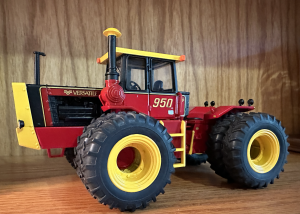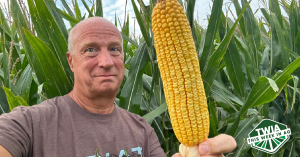Memories awoke recently when I added a Versatile 4WD to my toy tractor collection. It’s a relic of a by-gone era, when thick clouds of smoke bellowed across the Prairies and Plains as steel blades turned the soil. In the 1970s, high horsepower 4WD tractors were all the rage in the Midwest. And our western Illinois neighborhood was no exception.
I recall my dad beaming with pride the day he pulled into our drive occupying the seat of his new Versatile 835. My cousin just started working as a mechanic at a local equipment dealer that sold the red and yellow behemoths. Dad, my uncle and seemingly half our neighbors were all too happy to patronize. Dad had his CB handle, appropriately named Clodhopper, stenciled on it, while my uncle had his handle, Pappa Bear (he did have seven kids), stenciled on his. Along with Versatile’s light-green-colored competitors, Steigers, these specialty 4WD brands had a leg up on the mainstream models produced by Deere and IH. They were super heavyweights, packed with horsepower and built to haul heavy draft loads across the field. They oozed macho. Dad commented how his Versatile “just played with” his six-bottom plow and 30-foot field cultivator (regarded as very large by those days standards). They guzzled diesel fuel, which was relatively cheap at the time, and their massive fuel tanks meant you only had to fill up in the mornings. It was the tractor I spent much of my life on in the spring and fall, plowing and working down ground, and remained part of our fleet when I farmed on my own decades later. The dominance of these metal monsters was short-lived. In the late 1980s, front-wheel assist tractors (the front wheels were larger than the wheels found on conventional two-wheel drive tractor, but smaller than the rear tires, and mechanical drive powers all the tires to improve traction and pulling power) became the rave, due to their versatility, compaction-reducing lighter weight and fuel efficiency, making them cheaper to own and operate. Cultural practices also changed. Conventional tillage – which utilized multiple tillage passes to bury existing crop residue, leaving the soil surface bare – was giving way to conservation-focused, soil-saving practices, such as minimum till and no-till. This negated the need for the eight-tired giants. But in recent times, 4WD tractors have made a comeback. That’s due to the size and sophistication of the equipment that large farmers pull these days, including planters that feature 24, 36 and even 48 row units. Recent 4WD models have been reconfigured and many feature compaction-reducing tracks instead of rubber tires. But for me, that old Versatile will always be the baddest dude on the farm.

We’re ten weeks away from the Presidential election. And the political tickets are officially set. From the lens of agriculture, how do the candidates line up? Considering the top names on the ticket are from New York and San Francisco, that places them far away from farm country. There’s no hands-on farm experience to shout about. Does that matter? The last true farmer to serve in the White House, Georgia peanut grower Jimmy Carter, orchestrated the worst farm economy of my lifetime and spurred the 1980’s farm crisis. Yet a decade earlier, under a man born and raised in the elite circle of Boston, farm income grew to record levels. Despite having the least amount of farm experience of any President to that point, John F. Kennedy voiced this famous observation: “The farmer is the only man in our economy who has to buy everything he buys retail, sell everything he sells at wholesale, and pay the freight both ways.” So while farmers may find it nice to have a President who identifies with them, it’s far better to have one who understands them.
“Tailgate talking” is a big part of rural life. It’s what helps make farming the world’s greatest profession. You’re out scouting crops, working in the barnyard, or simply standing outside. A neighbor drives by, sees you, and pulls in to talk. Conversations are usually anything but political or controversial. They’re more about the simple things. They vary from “when are you going to cut your hay?” to “did you see the new tractor Bob bought” to of course, “when is it finally going to rain?” For us, a frequent tailgate talker was Jimmy Gumm. He was jovial sort, an avid tractor puller, prankster, and always seemed to be laughing. He was a true farm neighbor in every sense and a seemingly permanent fixture at our place. He’s the one who introduced me to my wife. The first one I called to ask about being a pallbearer at my dad’s funeral. And a shoulder to lean on when I first started farming on my own. He would jokingly say, “Fred isn’t your typical farmer neighbor. You can be scouting crops or working in the shop with him one day, and the next day he’s flying to Paris to cut a business deal.” Last week Jimmy passed away. I have no doubt he’s already seen dad by now, and they’ve been sitting on a tailgate, staring at the most beautiful landscape, talking about simple things.
Related Posts

This Week in Ag #25
36 years ago, a wide-eyed intern walked into the office of Indiana Prairie Farmer magazine. It was a baptism by fire. Paul Queck, the seasoned editor, told him, “We’d like to have you take a shot at writing what we hope to be the cover story for July. Since you’re only here for a few months, we

This Week in Ag #9
Regenerative agriculture is not some passing fad. It’s now a movement. And it’s here to stay. How can we be sure? Just look at who’s driving it. Unlike well-intentioned predecessors, such as LISA (Low Input Sustainable Agriculture), regen ag has a financial benefactor: food companies. From lofty goals articulated by their CEOs to multi-million-dollar investments, consumer

This Week in Ag #79
Seeing is believing. And I’m convinced the recent WASDE reports on crop production aren’t lying. Over the weekend we took my son to college. Our scenic journey through farm country – beauty is in the eye of the beholder, after all – took us deep into the Corn Belt. The projected 2024 corn yield in the Prairie State

